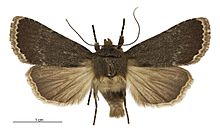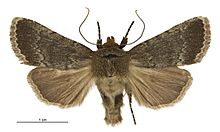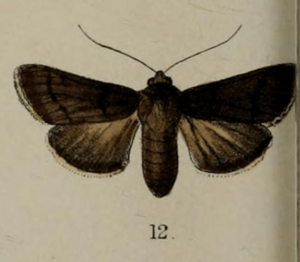Bityla sericea facts for kids
Quick facts for kids Bityla sericea |
|
|---|---|
 |
|
| Female | |
 |
|
| Male | |
| Scientific classification | |
| Kingdom: | |
| Phylum: | |
| Subphylum: | |
| Class: | |
| Order: | |
| Family: | |
| Genus: |
Bityla
|
| Species: |
B. sericea
|
| Binomial name | |
| Bityla sericea Butler, 1877
|
|
| Synonyms | |
|
|
Bityla sericea is a special kind of moth that lives only in New Zealand. This means it is endemic to New Zealand. It belongs to a family of moths called Noctuidae.
The New Zealand Department of Conservation has given this moth a special conservation status. It is listed as "At Risk, Naturally Uncommon." This means it is not found in many places and needs to be protected.
Contents
Discovering the Bityla sericea Moth
This moth was first officially described in 1877 by a scientist named Arthur Gardiner Butler. He studied a moth specimen that was found in the South Island of New Zealand.
Later, another scientist, George Hudson, wrote about and drew pictures of this moth. He included it in his books about New Zealand moths and butterflies. In 1905, George Hudson thought he had found a new type of moth. He named it Orthosia pallida. However, it turned out to be the same moth as Bityla sericea.
Years later, in 1988, John S. Dugdale confirmed that Orthosia pallida was actually the same as Bityla sericea. The original specimen that Arthur Butler used to describe the moth is kept safe at the Natural History Museum, London.
What Does Bityla sericea Look Like?
Bityla sericea moths have a shiny, grayish-brown color on their top wings. These wings have two dark lines that are a bit far apart. The outer line looks like small crescent shapes. The edges of their wings are wavy, and the fringe (the tiny hairs on the edge) is silky and whitish.
Their bottom wings are a pale brown color with a sandy-whitish fringe. The part of their body near the head, called the thorax, is grayish-brown.
These moths are similar to another moth called Bityla defigurata. However, you can tell Bityla sericea apart because it has a pale fringe on its front wings. The total width of their wings when spread out is about 1 inch and 6 lines (about 3.8 cm).
Where Do These Moths Live?
As we mentioned, Bityla sericea is found only in New Zealand. They have been seen in several areas across the country.
- Wellington
- Marlborough
- North Canterbury
- Mid Canterbury
- Central Otago
- Otago Lakes areas
They have also been collected in places like Thames and Napier.
Moth Behavior and Life Cycle
Adult Bityla sericea moths are usually seen flying between February and May. Like many moths, they are attracted to light. This means you might spot them near outdoor lights at night.
Scientists are still learning about the life cycle of these moths. For example, we don't yet know what the caterpillars of Bityla sericea eat. However, it is thought that they might feed on plants from the Muehlenbeckia family.
Protecting Bityla sericea
Because this moth is only found in New Zealand and is not very common, it has been given a special conservation status. The New Zealand Threat Classification System lists it as "At Risk, Naturally Uncommon." This helps conservationists keep an eye on the species and work to protect its natural habitats.


